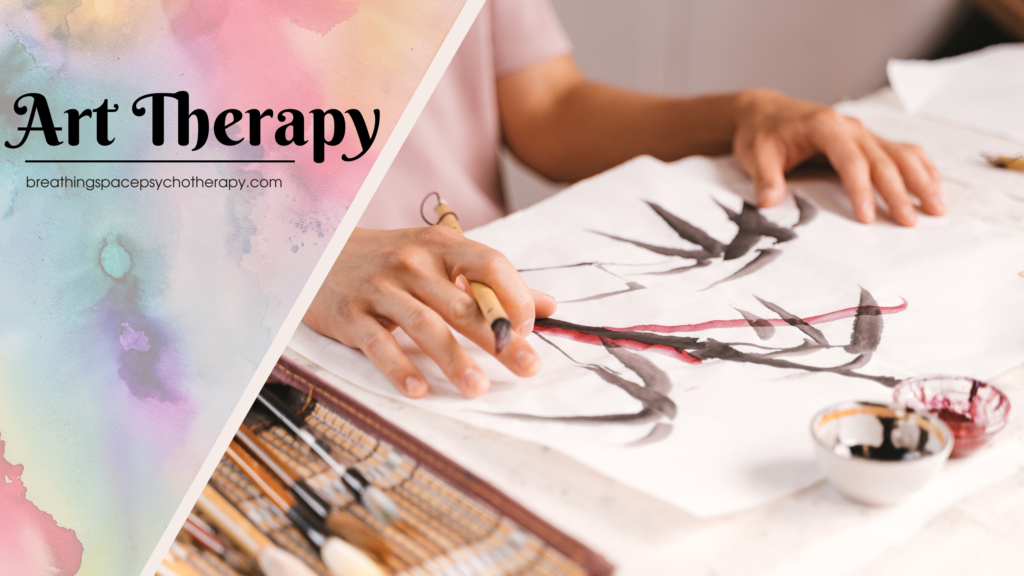| Misconception: Art therapy is like an arts and crafts class. Truth: Art therapy is not an instructional art class because the art therapist is not a teacher and is not teaching you how to draw, paint, or develop artistic skills. The art therapist does not critique or judge the quality of your artwork. Rather, art therapy is a therapy that incorporates elements of talk therapy with art-making. The art therapist invites you to explore different art media, view your own art, and make meaning about your experiences from your art. |
How does art therapy work?
Art therapy allows you to express yourself through the process of making art. Art-making is a nonverbal process that helps people process, understand, and resolve their problems. It allows you to focus on the experience of your feelings, rather than focusing on “translating,” or verbalizing, your feelings.
Art therapy is therapy; art-making is therapeutic.
Art therapy does not focus on the quality of the end product. Neither will the art therapist judge, critique, grade, or analyze your artwork. Instead, art therapy is about the process of making art. It’s about what you take away from the process and the meaning you make from your art.
Who can use art therapy?
Anyone of any age can utilize art therapy.
From children to teenagers to adults to senior citizens, you are never too old or too young to benefit.
| Misconception: Art therapy is only for children. Truth: Art therapy is for everyone at any moment in their life. |
Anyone facing any kind of struggle can benefit from art therapy.
- People who have a mental health issue or disorder;
- People struggling with health or an illness;
- People who have experienced a traumatic brain injury;
- People with developmental disabilities;
- People who want to understand themselves better;
- People who want to explore their identity, gender identity/expression, sexual orientation, and personal expression;
- People who want to understand what has happened to them in the past or present and why it happened;
- People who have experienced trauma or loss;
- People who are struggling with an issue at the moment;
- People who don’t have the cognitive capacity to talk about their experiences, who are nonverbal, or who find it difficult to talk about their experiences…
There is no right or wrong reason to utilize art therapy.
Who benefits from art therapy?
Anyone, regardless of their level of artistic skill, can participate and benefit.
- If you are a beginner, have no artistic skills, or haven’t made art since you were a kid in elementary school, you can participate in art therapy. The art therapist will help you find the medium that will be easier for you to express yourself.
- If you don’t feel confident about your art, you can participate in art therapy. Art therapy focuses on the process of art-making rather than the quality of the final product.
| Misconception: “You need to be creative and good at art to benefit from art therapy.“ “I’m not creative enough to take art therapy.” “I can’t make art.” “I have no art skills, so I can’t use or benefit from art therapy.” Truth: You don’t need artistic skill or confidence in your creativity to participate in and benefit from art therapy. |
What does the art therapist do?
Some individuals are hesitant to participate in art therapy because they have had negative experiences with art classes. They may have had a strict, critical, or judgmental art teacher or were graded poorly in their art class. For these individuals, it’s important to know that the art therapist will not judge, criticize, or grade your artwork, nor will they tell you how you should make art or how your art should look. Instead, the art therapist will help make room for what shows up in your art. They will guide you to make your own meaning and interpretation from your artwork.
| Misconception: The art therapist can analyze your artwork and figure out who you are, what you’re thinking, what your situation is, etc. Truth: An art therapist will have a lot of experience with looking at other people’s art, but the therapist cannot and will not analyze your artwork. The therapist is not there to tell you what you feel; instead, the therapist invites you to explore your feelings and thoughts through your artwork and to make your own meaning from your art. While the art therapist is a mental health expert and has a lot of experience with art, only you are the expert of yourself. Only you can tell the therapist, or anyone, what you are thinking or feeling. |
Does art therapy work? Is it effective?
While research shows that art therapy can be beneficial for many populations, further research is needed to study its effectiveness.
Why art therapy may not work
While artistic skill and confidence are not necessary for art therapy to be beneficial, people who believe they aren’t creative, have no artistic skills, or have had negative experiences with art may be resistant or skeptical of the process. Thus, they may not receive the benefits that art therapy has to offer. Instead, they may benefit more from other types of therapy—such as other creative therapies or talk therapies.
What does an art therapy session look like?
Each session is unique and should be customized to each client and what they need from the session. Art therapy sessions can be conducted in multiple formats:
- with a community,
- in groups,
- with family,
- with couples,
- individual.
Art therapist, Youhjung, outlines 4 sections of an individual session: check-in, art-making, discussion, and closure. The amount of time for each section depends on the therapist, the client, and where the client is emotionally and mentally for the session. The order of sections is also fluid and does not have to follow this order.
Check-in
The check-in takes place at the beginning of the session. The art therapist and client use this time to follow up on the last session. The amount of time can vary from a few minutes to most of the session, depending on where the client is at and how much they want to verbally express themselves at that moment.
- Catch up on how the client has been;
- The client can share anything about where they are at in their life right now;
- Review therapeutic goals;
- Review what the client needs to address during the session;
- Decide what they will do during the session.
The check-in section can transition into the discussion/verbal processing section or can flow into the art-making section.
Art-making
During the art-making section, the client (and sometimes the therapist) makes art and engages in the creative process. Art-making differs from session to session, depending on the therapist, the client, the client’s progress, the goal of the session, the art materials available, and other factors.
There are typically two types of art-making structures:
- Structured art-making is when the therapist gives structure to the art-making process. The therapist may give a “personalized directive,” such as a prompt, exercise, or activity. A directive gives the client direction during the creative process and is carefully and intentionally presented by the therapist. The directive is chosen on the client’s needs and goals and is used to help the client process a problem or a feeling they want to work through.
- Unstructured art-making is when the client leads the art-making process. Essentially, the therapist creates space for the client to create whatever they want to create. This type of art-making is more self-motivated and self-directed.
The nature of the art-making process during sessions is personalized. It depends on what is most therapeutic and comfortable for the client. Some clients prefer to talk; some prefer no talking; some prefer to have music playing. The art therapist may be creating art alongside the client, or they may be holding space while the client makes art.
| Misconception: You have to make art in every art therapy session. Truth: You don’t have to make art in every single art therapy session. Some sessions are made just to talk; some sessions are made just for art-making; and some sessions will have a mixture of talking and art-making. The content of each session depends on the client’s progress and needs during that session. |
Discussion, or Verbal Processing
During the discussion section, the client reflects on their artwork and the therapist asks questions about the client’s art. The therapist and client can talk about the artwork, the client’s process of creating the artwork, and what feelings or thoughts came up.
The client may use their art as a metaphor to explore different possibilities and gain more perspective. They can also explore their art and create their own narrative of what is happening in their art, which in turn may help them find new solutions and gain more insight into themselves and their situation.
Verbal processing, or discussion, is an important part of art therapy because it may feel difficult for the client to manage, process, or feel in control without talking. Talking with the therapist can help the client manage and process their feelings, thoughts, and experiences. The discussion allows the therapist to provide extra insight, perspective, and tools for the client to utilize.
Check-out, or Closure
The check-out takes place at the end of the session. The therapist helps create closure for the session and transition the client from the session back to daily life with a sense of peace and grounding. The therapist and client may reflect on the session, talk about what the client wants to accomplish by the next session, and discuss a prompt or exercise the client can try. They may also conduct a closing ritual, such as a grounding exercise, a body scan, or another check-in.





